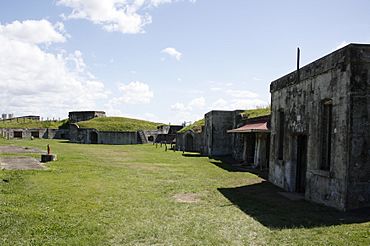Fort Lytton National Park facts for kids
Quick facts for kids Fort Lytton National ParkQueensland |
|
|---|---|
|
IUCN Category II (National Park)
|
|

Inside the moat of the fort.
|
|
| Established | 1990 |
| Area | 0.13 km2 (0.050 sq mi) |
| Managing authorities | Queensland Parks and Wildlife Service |
| See also | Protected areas of Queensland |
Fort Lytton National Park is a special place in Lytton, City of Brisbane, Queensland, Australia. It's like a time capsule, showing us how people lived and protected the city long ago. The park's main attraction is the amazing Fort Lytton Historic Military Precinct. Here, you can take tours, explore a museum, and even see exciting re-enactments of history.
This park became Queensland's very first historic national park in 1990. It started with just the old Fort Lytton, a fort built to guard the coast. Later, in 1999, the park grew to include the Lytton Quarantine Station. Both the fort and the quarantine station are important historical sites. The park is about 13 kilometres (8.1 mi) northeast of the Brisbane CBD, right near where the Brisbane River meets the sea.
Contents
Exploring Fort Lytton: Brisbane's Historic Defence
Fort Lytton was built a long time ago, between 1880 and 1881. Its job was to protect Brisbane and its port from any attacks by ships. When Australia's colonies joined together to form a country in 1901, the fort became part of the new Australian government.
The fort stayed an active military base until shortly after World War II. After that, it slowly closed down. The land and fort were sold in 1963 to an oil company, Ampol, to build a refinery. However, some parts of the land were very important historically. In 1988, Ampol gave the original fort area back to the Queensland Government. This is how Fort Lytton National Park was created in 1990.
You can visit Fort Lytton for free on Sundays and most public holidays. It's a great chance to take guided or self-guided tours of the old fort and other military buildings. There's also a military museum and sometimes you can watch historical re-enactments.
Lytton Quarantine Station: A Place for New Arrivals
The Lytton Quarantine Station was built in 1913–1914. Its purpose was to house new immigrants and anyone who might carry illnesses. This helped keep the general population safe. The quarantine station was right next to Fort Lytton.
By the late 1980s, the station was no longer needed and closed completely. In 1988, the Queensland Parks and Wildlife Service took over managing part of the site. This included the old jetty. In 1999, the quarantine station officially became part of Fort Lytton National Park.
The quarantine station buildings are usually only open to the public on special days. However, you can always walk around the outside of the buildings and imagine what it was like for people arriving in Australia. The park's Visitor and Information Centre used to be the quarantine station's laundry!
Fort Lytton Military Museum: Discovering History
The museum at Fort Lytton National Park has a huge collection of over 2,000 items. These historical objects are displayed all around the park. You can find them in five buildings, six gun pits, two shelter structures, and even in open-air spots.
It's free to enter the museum. However, some special areas, like the submarine mining building and the black powder rooms, can only be seen on a guided tour. The Old Dining Hall holds an even bigger collection, with over 10,000 items about Queensland's military past. It's a fantastic way to learn about the soldiers and events that shaped the region.
Helping the Park: Volunteers and History Lovers
Soon after Fort Lytton National Park opened in 1990, a group of volunteers started helping out. They wanted to create a great historical exhibit for everyone to enjoy. This group later became the Fort Lytton Historical Association (FLHA) in 1999.
The FLHA is a non-profit group of volunteers. They offer free guided tours of the Fort on Sundays and public holidays. They also run the Visitor Information Centre and sell small refreshments. These volunteers work hard to keep the park's history alive and interesting for visitors like you.
In 2019, another historical group, the Queensland Military Historical Society, moved its collection to the old Dining Hall at Fort Lytton. This means even more amazing historical items are now available for visitors to see and learn from at the park.
See also
 In Spanish: Parque nacional Fuerte Lytton para niños
In Spanish: Parque nacional Fuerte Lytton para niños


